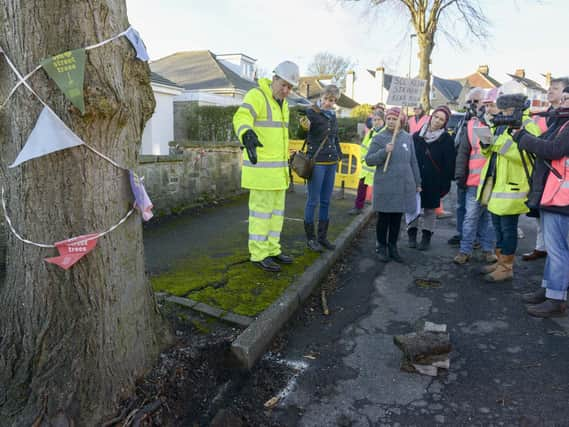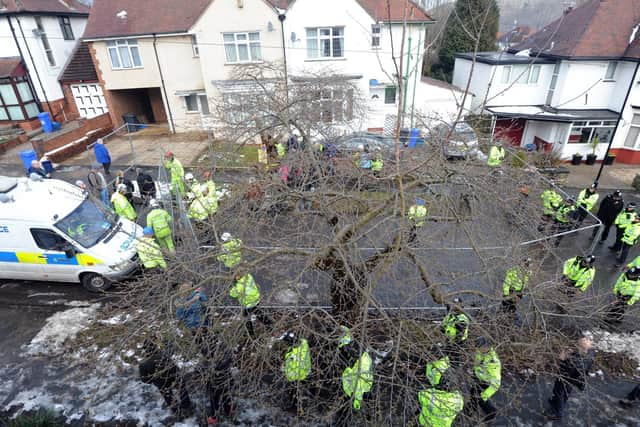New Sheffield street tree strategy bids to prevent repeat of bitter felling saga


The first Partnership Street Tree Working Strategy for Sheffield will be recommended to Sheffield Council for adoption next week after being developed by representatives from the local authority, its highways contractor Amey, members of Sheffield Tree Actions Groups, the Woodland Trust and independent experts.
The fallout from the city’s street tree saga has also seen the inclusion of a so-called ‘Sheffield clause’ in the new Environment Bill which states local authorities will have a legal duty to consult with residents on the felling of street trees in future.
Advertisement
Hide AdAdvertisement
Hide AdSheffield Council started a £2bn, 25-year highways improvement contract with Amey in 2012 called Streets Ahead but it became mired in controversy due to the element of the scheme involving the removal of thousands of street trees and their replacement with saplings.


Environmental campaigners argued that many healthy trees were being cut down unnecessarily for contractual reasons. A major police operation was launched in early 2018 to support felling operations after clashes between protesters and private security guards. The operation ended a month later after widespread national condemnation of the approach of the authorities following multiple arrests of campaigners and cost the police more than £47,000 in overtime and since then a new approach designed to save more trees from felling has been adopted.
The new strategy, which will go out to public consultation before being finalised, is based around managing street trees in accordance with best practice and increasing street tree canopy cover in the city.
Liz Ballard, chief executive of Sheffield & Rotherham Wildlife Trust and chair of the Sheffield Street Tree Strategy Development Group said: ‘We set out to develop an exemplary Partnership Street Tree Strategy for Sheffield that values street trees for the benefits they bring to people, the city and the wider environment. And we believe this Working Strategy is just that.
Advertisement
Hide AdAdvertisement
Hide Ad“As a group we wanted to produce something positive and visionary - for the city to collectively view street trees as an asset, helping us to improve air quality, reduce flood risk, support wildlife and store carbon. This strategy aims to learn from the past in order to deliver our vision for the future of Sheffield’s street trees.”
Paul Selby from STAG said: “This Working Strategy is the culmination of seven months collaboration between a whole range of partners, and I am personally extremely grateful to all those who have contributed their time and expertise. Assuming the strategy is adopted and implemented by Sheffield Council, Sheffield residents can be confident that their street trees will be protected, sustained, and increased in number. The benefits of this new and enlightened approach will be felt not just by current generations, but future generations too.”
Councillor Mark Jones, Cabinet member for Environment, Streetscene at Climate Change at Sheffield City Council: “We live in a city famous for its greenery, something many of us are rightly proud of. We have almost five million trees covering our streets, parks and woodlands. That’s approximately eight trees for each person who lives here. It is really important that we have a tree strategy that supports a sustainable and future-proof approach to managing our growing street tree stock.
“Trees matter. Not only do they help improve air quality and support wildlife but they have also been proven to benefit our mental health. We need better and more robust measures in place to make sure trees across Sheffield continue providing value to our natural and urban environment.
Advertisement
Hide AdAdvertisement
Hide Ad“To make this strategy work for the city, we need feedback and collaboration from a range of stakeholders, partners and residents. Engagement is key for creating a way forward that works for us all, not just for now, but for many years to come.
“We’ve not always got the approach to street trees right. However, through the hard work and dedication of the development group and many others we have created this new strategy, one which ensures we listen carefully to all viewpoints and will shape how we do things better.
“Through this new way of working, we are committed to retaining trees wherever possible, planting additional trees, increasing canopy cover and building a more diverse and resilient street tree stock with varying species and age profiles.
“It’s not just about the number of trees we have; it’s about caring for them in the right way and maximising their many benefits whilst ensuring that our city can still develop and thrive in these times of continuous change.”
Advertisement
Hide AdAdvertisement
Hide AdDarren Butt from Amey added: “We have welcomed the opportunity to sit down with all partners to discuss and agree a shared vision for street trees in Sheffield. By engaging with local communities and members of STAG we have a solid foundation from which to build, continuing to work collaboratively, achieving the outcomes that benefit everyone in the city. We are confident that our working relationships are stronger and more resilient as a result going forward.”
Joseph Coles, Urban Lead for the Woodland Trust, said: “This Strategy Development Group is an example of the value in a collaborative approach to developing a strategy that achieves our shared ambitions for a greener Sheffield. As part of the Trees and Woodland Strategy, it embeds a holistic approach to managing Sheffield’s urban forest, and instils confidence in the sustainable future of Sheffield’s street trees. We are pleased to support an approach that has recognised residents as a key stakeholder with an important role to play”